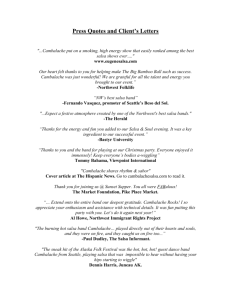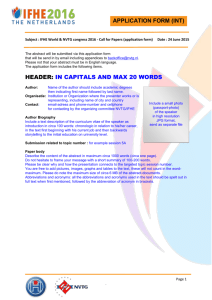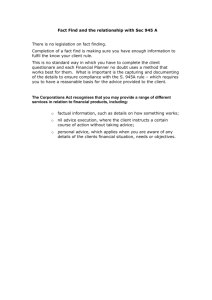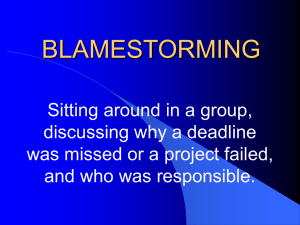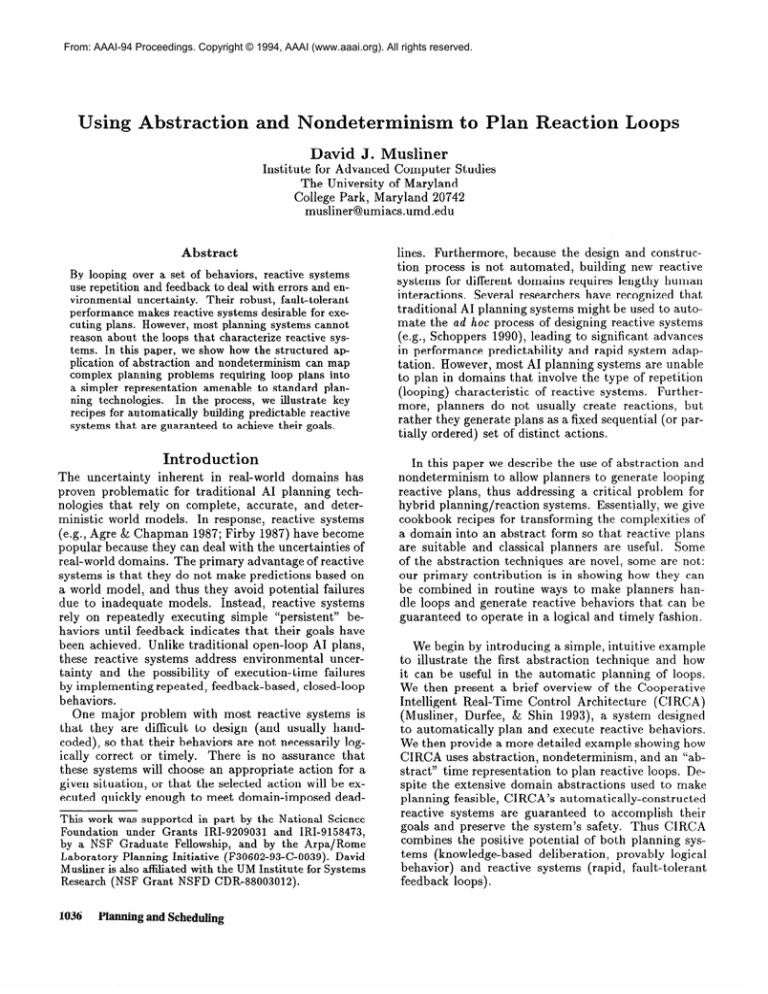
From: AAAI-94 Proceedings. Copyright © 1994, AAAI (www.aaai.org). All rights reserved.
Using Abstraction
and Nondeterminism
to Plan Reaction Loops
David J. Musliner
Institute
for Advanced Computer
Studies
The University of Maryland
College Park, Maryland 20742
musliner@umiacs.umd.edu
Abstract
By looping over a set of behaviors,
reactive systems
use repetition and feedback to deal with errors and environmental
uncertainty.
Their robust, fault-tolerant
performance
makes reactive systems desirable for executing plans. However, most planning systems cannot
reason about the loops that characterize
reactive systems. In this paper, we show how the structured
application of abstraction
and nondeterminism
can map
complex planning problems requiring loop plans into
a simpler representation
amenable to standard
planning technologies.
In the process,
we illustrate
key
recipes for automatically
building predictable
reactive
systems that are guaranteed
to achieve their goals.
Introduction
The uncertainty
inherent
in real-world
domains has
proven problematic
for traditional
AI planning
technologies that rely on complete,
accurate,
and deterministic world models.
In response, reactive systems
(e.g., Agre & Chapman
1987; Firby 1987) have become
popular because they can deal with the uncertainties
of
real-world domains. The primary advantage of reactive
systems is that they do not make predictions
based on
a world model, and thus they avoid potential failures
due to inadequate
models.
Instead,
reactive systems
rely on repeatedly
executing
simple “persistent”
behaviors until feedback indicates that their goals have
been achieved. Unlike traditional
open-loop AI plans,
these reactive systems address environmental
uncertainty and the possibility
of execution-time
failures
by implementing
repeated, feedback-based,
closed-loop
behaviors.
One major problem with most reactive systems is
that they are difficult to design (and usually handcoded), so that their behaviors are not necessarily logically correct or timely.
There is no assurance
that
these systems will choose an appropriate
action for a
given situation,
or that the selected action will be executed quickly enough to meet domain-imposed
deadThis work was supported
in part by the National Science
Foundation
under Grants
IRI-9209031
and IRI-9158473,
by a NSF Graduate
Fellowship,
and by the Arpa/Rome
Laboratory
Planning Initiative (F30602-93-C-0039).
David
Musliner is also affiliated with the UM Institute for Systems
Research (NSF Grant NSFD CDR-88003012).
10%
Planningand Scheduling
lines. Furthermore,
because the design and construction process is not automated,
building new reactive
systems for different domains requires lengthy human
interactions.
Several researchers have recognized that
traditional
AI planning systems might be used to automate the ad hoc process of designing reactive systems
(e.g., Schoppers 1990), leading to significant
advances
in performance
predictability
and rapid system adaptation. However, most AI planning systems are unable
to plan in domains that involve the type of repetition
(looping) characteristic
of reactive systems.
Furthermore, planners
do not usually create reactions,
but
rather they generate plans as a fixed sequential (or partially ordered) set of distinct actions.
In this paper we describe the use of abstraction
and
nondeterminism
to allow planners to generate looping
reactive plans, thus addressing
a critical problem for
hybrid planning/reaction
systems. Essentially, we give
cookbook recipes for transforming
the complexities
of
a domain into an abstract form so that reactive plans
are suitable and classical planners
are useful.
Some
of the abstraction
techniques
are novel, some are not:
our primary contribution
is in showing how they can
be combined in routine ways to make planners
handle loops and generate reactive behaviors that can be
guaranteed
to operate in a logical and timely fashion.
We begin by introducing
a simple, intuitive example
to illustrate
the first abstraction
technique
and how
it can be useful in the automatic
planning
of loops.
We then present a brief overview of the Cooperative
Intelligent
Real-Time
Control Architecture
(CIRCA)
(Musliner,
Durfee, & Shin 1993), a system designed
to automatically
plan and execute reactive behaviors.
We then provide a more detailed example showing how
CIRCA uses abstraction,
nondeterminism,
and an (‘abstract” time representation
to plan reactive loops. Despite the extensive domain abstractions
used to make
planning feasible, CIRCA’s automatically-constructed
reactive systems are guaranteed
to accomplish
their
goals and preserve the system’s safety. Thus CIRCA
combines the positive potential
of both planning
systems (knowledge-based
deliberation,
provably logical
behavior)
and reactive systems (rapid, fault-tolerant
feedback loops).
OPERATOR precise-hammer-blow
PRECONDS: ((arm-raised
T) (nail-height
POSTCONDS: ((arm-raised
nil)
(nail-height
(max 0 (- ?X
?X))
1.2))))
ACTION hammer-blow
PRECONDS: ((arm-raised
POSTCONDS: (((arm-raised
((arm-raised
Figure
1: A fictitious
Pl an
hammering
that might result.
operator
(nail-flush
(nail-flush
2: A nondeterministic
sulting
Figure
T))
nil)
nil)
transition,
dynamically-terminated
T))
nil)>)
and the reloop.
and the
A Simple Example
In his early work on representing
plan loops, Drummond (1985) illustrates a plan for hammering
a nail by
repeatedly
raising and lowering a hammer, never terminating.
In this section, we introduce
our approach
to planning
loops using this same example, with two
significant differences: first, our hammering
plan is automatically
generated, and second, the plan will terminate when the nail is driven flush.
Consider first the way in which a (hypothetical)
traditional planning system might address the hammering
problem, as illustrated
in Figure 1. Here the precisehammer-blow
operator must specify exactly how far
down it drives the nail, and the final plan yields a world
model that enumerates
all the possible heights the nail
may protrude.
The hammering
domain illustrates
several critical
aspects of looping plans that make them difficult for
planners.
First, uncertainty
may make it impossible
to specify an operator’s effects so precisely, and hence
impossible to predict exactly how many loop iterations
will be necessary to achieve the goal. In such uncertain domains, the termination
conditions
of the loop
can only be determined
during the actual execution
of the loop.
However, traditional
planning
operator
representations
(e.g., STRIPS
add/delete
lists (Nilsson 1980)) cannot represent an operator whose effects
are not fully deterministic’.
Another major problem
is that, even if we could predict how many iterations
are necessary, a classical planning
system would need
to enumerate
at least one state (and probably many)
for each of the iterations.
This is obviously undesirable, since it exacerbates
the state-space
explosion already experienced
by classical planners.
To address
these problems and allow a planner to derive a compact plan without considering
innumerable
states, we
apply two forms of abstraction’.
‘A deterministic
operator
implements
a fixed mapping
of an input to a unique corresponding
output. A nondeterministic operator
implements
a completely
uncertain
(or
random) mapping from an input to one of a set of possible
outputs.
‘We use “abstraction”
in a general sense to mean the
omission of detail.
This usage conforms
nicely with in-
First, we must abstract
away the details in the
domain representation
that cause problems
with the
state-space
explosion.
In the hammering
domain, the
height of the nail is the domain feature that changes on
each loop of the plan, so it is the culprit, the “counting”
variable.
We remove this counting effect by abstracting the height feature to two critical values: either the
nail is flush or it is not.
Since the height of the nail has been abstracted
away
to a binary value, the effects of the hammer-blow
operator must be similarly abstracted.
In the process,
the excessive precision associated with the continuousvalued operator is abstracted
away, and nondeterminism is used to represent the resulting uncertainty.
Figure 2 shows the abstracted
operator, whose effects are
now represented as a nondeterministic
transition
either
to (nail-flush T) or back to (nail-flush nil).
So now we have the world model shown in Figure 2,
which more accurately
reflects the uncertainty
of the
real world: the nail is initially sticking out above the
surface, and we can keep hitting it until it is finally
flush with the surface, at which time we will move out
of the loop and into state 6. Summarizing
the techniques used thus far, we have the following recipe:
Recipe
1: Eliminating
Counting
Variables
1. Create a binary variable with T and nil states corresponding
to the critical “some or none” transition
of the counting variable.
2. Modify the increment operator to lead to the T state
of the binary variable.
3. Modify the decrement operator to be nondeterministic, leading to either of the binary variable’s states.
With the abstract nail-flush feature and the corresponding operator,
the state-space
problem has been
addressed
and the model in Figure 2 represents
the
need for a loop which repeats until a dynamic termination condition holds. Note that the hammer-blow
action is not sufficient by itself, because we do not want
to hit the nail every time we are holding up the hammer. To build a reaction that would yield the statespace behavior shown in Figure 2, ule still need a pdanner to decide which of the various applicable operators
should actually be executed in any particular
world
tuition,
as well as with (Wilkins 1988),
stract models match larger sets of possible
abstract
models.
in that our abworlds than less-
Agents
1037
TAP hammer-blow
TEST: (and (nail-flush nil) (arm-raised T))
ACTION: hammer-blow
MAX-PERIOD: 2 seconds
SCHEDULE: (raise-arm hammer-blow) repeat
/
Figure
\
3: Overview
of CIRCA.
state. The planner must decide that we should invoke
action only when the nail is not
the hammer-blow
yet flush (i.e., in state B only, not in state 6). In the
next section, we briefly describe how CIRCA is able
to perform this type of planning
(despite the resulting state-space
loops), and how the system addresses
the final problem of the hammering
domain
actually
representing
a looping plan.
Overview
of CIRCA
As illustrated
in Figure 3, CIRCA consists of three
subsystems
operating
in parallel (Musliner, Durfee, &
Shin 1993). The AI Subsystem (AIS) acts as a planning
system, reasoning about a model of the domain and deriving appropriate
reaction plans. These plans are sent
to the Scheduler module, along with timing constraints
expressing how frequently
each reaction must be executed. The Scheduler tries to build a cyclic schedule
of reactions that will meet all the timing constraints.
If a schedule is found, the planned
reactions
can be
sent to the Real-Time Subsystem
(RTS) for execution.
The RTS executes previously-derived
plans while the
developing a new
AIS and Scheduler are cooperatively
plan; each reaction plan is designed to keep the-system
safe (avoiding failures), so that the search-based
planning performed by the AIS is isolated from the ongoing
real-time deadlines of the environment.
CIRCA’s reactive plans are built as schedules of
Test-Action
Pairs (TAPS). As shown in Figure 4, each
TAP is an annotated
production
rule consisting
of a
test expression,
an action, and a timing constraint
on
how frequently
the TAP must be executed. When executing a TAP, the RTS evaluates the test expression
and, if it returns true, the RTS executes the corresponding action. TAPS differ from other reactive mechanisms such as RAPS (Firby 1987) in two fundamental ways: first, TAPS are automatically
generated
by
CIRCA’s planning
system, and second, TAPS specify
how frequently they must be executed in order to meet
domain deadlines.
CIRCA’s Scheduler module uses the
TAP timing requirements
when it builds TAP schedules that are themselves loops; Figure 4 shows a simple
schedule for the hammering
domain, which oscillates
between the raise-arm and hammer-blow
TAPS.
The world model and planning
algorithm
that
the AIS uses to develop TAP plans are detailed in
(Musliner, Durfee, & Shin 1994). For our purposes, it
is sufficient to understand
that the model is a modified
state/transition
graph in which states correspond
to
complete descriptions
of the world (modulo some level
1038
Planningand Scheduling
Figure
4: A trivial
example
for the hammering
TAP & TAP
domain.
schedule
of abstraction),
and three types of transitions
represent
Temporal transitions
the ways the world can change.
represent time and ongoing processes. The timing behavior of a temporal
transition
is related to the rate
of the process it represents:
for example, the process
of consuming
a jar of salsa will take some minimum
amount of time to complete, depending
on the rate of
consumption.
Event transitions represent
occurrences
outside the agent’s control, while action transitions
represent the intentional
actions of TAPS. CIRCA can
control the timing behavior
of action transitions
by
setting the timing constraints
of TAPS. For example,
CIRCA can build a TAP that executes at least once every minute, to ensure that a new jar of salsa is opened
within two minutes after the last jar is finished.
To build plans, CIRCA begins with a set of goal descriptions,
a set of initial world states, and a set of
transition
descriptions
that detail the types of events,
actions,and processes possible in the world. The planning algorithm
pushes the initial states onto a stack
and then performs
a modified
STRIPS-like
depthfirst search for a plan that satisfies all the system’s
goals. On each planning
loop iteration,
the top state
is popped off the stack and all applicable
event and
temporal transitions
are applied, generating new reachable states that are pushed onto the stack. The planner
uses a multi-step lookahead heuristic to choose the best
action for the current state, generates the states that
result from the selected action, and then repeats the
planning loop. Chronological
backtracking
is initiated
if the planner cannot find a good plan (e.g., if it cannot
avoid a catastrophic
failure state).
To illustrate the planning process, consider again the
nailing domain example in Figure 2. If state A is the
initial condition
given to the planner,
it will choose
to apply the raise-arm action, generating
state B. In
state B, when the hammer-blow
action transition
is
applicable,
the planner will project forward both of
the action’s possible postconditions,
and will recognize
that it may lead to the desired state 6, where (nailaction will
flush T) holds. Thus the hammer-blow
be chosen correctly to accomplish the task. Projecting
forward along the other branch of the nondeterministic postconditions,
the planner will also realize that the
action transition
may loop back onto state A. Since an
action has already been selected for that state, no further planning
is necessary.
Thus the nondeterminism
poses no difficulty, and CIRCA can easily plan looping
behaviors with dynamic termination
conditions.
The repetition
itself is inherent
in all of CIRCA’s
plans, because they are implemented
not as traditional
sequential plans but as reactive TAP plans. The RTS
continually
loops over the schedule of TAPS, repeatedly testing their applicability
conditions
and executing their actions whenever appropriate.
Thus, if the
world model contains a loop (i.e., the planner thinks
the world may re-enter a state it has been in before),
the TAP form of the control plan already ensures that
the state will be recognized
and appropriate
action
taken, as many times as necessary.
The planner does
not need to perform any additional
reasoning
to accommodate
repeated behaviors.
A More
Complex
Example
Several aspects of the hammering
domain make it particularly simple, including the lack of events and temporal transitions
(processes),
the lack of timing requirements
such as deadlines,
and the simple goal of
achievement.
To extend beyond those limitations,
we
introduce
the “grocery stocking” domain, in which an
agent must never run out of a particular
grocery item
(say, salsa). The agent must develop a plan that coordinates
opening new jars of salsa, putting salsa on
the shopping list when stock runs low, and going grocery shopping to replenish the stock. There are several
tough problems
hidden in this seemingly
simple domain, including plan loops, a counting variable, and a
special type of goal.
However, before we address these problems with the
abstraction
techniques
described above, we must first
utilize a different form of abstraction
called indezicul
feutwes (Agre & Chapman
1987). This technique
is
used to avoid the enumeration
problems
that result
from individuating
specific objects in the environment.
For example, if the planner distinguished
between individual salsa jars (e.g., jar21 and jar22) it would have
to know all the possible jar names ahead of time, or
else it would need the ability to generate new names,
and the state space would be infinite.
To avoid this problem, we encode the environment
using indexical features, which refer to objects by their
relationship
to our agent. For example, we can use a
feature have-open-salsa
to indicate that a jar of salsa
is currently
being consumed,
but the specific identity
of that jar need never be established.
Indexical features thus abstract away from the identity of objects,
but they do so in a slightly unusual fashion. The mapping of individual objects to their “classification”
by indexical features is dynamic, changing as objects move
through the world.
So the salsa jar that is open at
one time may be different than the jar open at another
time, but the agent’s representation
will not indicate
any difference.
Many reactive systems use indexical features to avoid
the difficulties of establishing
symbol grounding
and
“object permanence”
through sensing (e.g., determining that the jar you leave in the refrigerator
is jar21,
and that it is the same one you find there the next
ACTION open-new-jar
PRECONDS: ((have-salsa-in-stock
T) >
POSTCONDS: ( ((have-open-salsa T)
(have-salsa-in-stock T))
((have-open-salsa T)
(have-salsa-in-stock nil>> >
MAX-DELAY: 5 minutes
ACTION put-salsa-on-list
PRECONDS: 0
POSTCONDS: ((salsa-on-list T))
MAX-DELAY: I minute
ACTION go-shopping-and-get-salsa
PRECONDS: ((salsa-on-list T))
POSTCONDS: ((have-salsa-in-stock T)
balsa-on-list nil))
MAX-DELAY: 1 hour
TEMPORAL finish-salsa-jar
PRECONDS: ((have-open-salsa T))
POSTCONDS: ((have-open-salsa nil))
MIN-DELAY: 2 days
TEMPORAL starve-without-salsa
PRECONDS: ((have-open-salsa nil))
POSTCONDS: ((failure T))
MIN-DELAY: 8 hours
GOALS : ( (failure nil)
>
INITIAL STATE: ((salsa-on-list nil)
(have-open-salsa T)
(have-salsa-in-stock T))
Figure
5: Example
stocking
domain
problem
description
for the salsa-
day). Although common among reactive systems, indexicality is rare among traditional
planning syste ms,
which usually name objects individually.
Recipe
2: Eliminating
Named
I. Replace non-indexical
state
agent-oriented
features.
2. Modify related operators.
Because
pletely
include
features
the agent may stock
Objects
with indexi Cal,
up on salsa,
a com-
accurate model of the problem would have to
a variable indicating exactly how many jars are
in stock at any time.
We have already seen how such
counting variables can cause problems with state-space
enumeration
and overly-precise
operators.
Therefore,
we apply Recipe 1 to convert the counting variable into
a binary feature.
The salsa domain also introduces
a different type of
goal: a goal of avoidance (never run out of salsa), rather
than a goal of achievement
(make the nail flush)3.
Along with the new type of goal comes the complexity of representing
time and ongoing processes in the
3Goa,lsof avoidance (e.g.,avoid (out-of-salsa T))
might also be thought of as goals of negated maintenance
(e.g., maintain (not (out-of -salsa T) )).
Agents
1039
world. To make sure that the agent does not starve
from lack of salsa, the planner must reason about the
relative speeds and frequencies of shopping trips, salsa
consumption,
and other activities.
While there have been many forays into temporal
representations
for planners
(e.g., Allen 1983), none
have focused on the sort of repeated, long-term behaviors we are interested in producing.
Instead, most temporal logic systems focus on maintaining
partial ordering constraints
among time intervals, for non-looping
plans. Plan loops would pose severe problems for these
approaches, in part because the duration of a loop may
not be determined
until runtime.
Instead, we introduce
an abstracted form of time information
that is simple to
manipulate,
yet allows CIRCA to build reactive plans
that are guaranteed
to meet domain deadlines.
Figure 5 shows a sample set of CIRCA transition
descriptions
for the salsa domain.
We have applied the
previously-described
abstraction
techniques
to eliminate the stock-counting
variable, instead using the binary variable have-salsa-in-stock.
The action of buying more stock now simply sets have-salsa-in-stock
to T, and removing a jar from stock has a nondeterministic outcome,
either leaving some stock, or not.
The process of salsa consumption
is represented
by the
temporal
transition
finish-salsa-jar,
indicating
that
the agent takes at least two days to consume a jar. The
goal of avoidance is expressed by the starve-withoutsalsa temporal transition,
which indicates catastrophic
failure will occur if the agent has no open jar of salsa
for eight hours.
These latter temporal transitions
embody our recipe
for temporal abstraction:
rather than representing
detailed information
about the rate at which a process
proceeds (which may vary with domain features (e.g.,
menus, time of day)), we abstract that information
to
a single worst-case number.
For temporal transitions,
this is the shortest possible time until the transition
to
a new state might occur. For action transitions,
the
worst case is the longest possible time until the action
will occur. These worst-case values can then be used
to derive the rates at which various reactions must be
executed in order to achieve their goals. In the salsa domain, we must ensure that the starve-without-salsa
transition
to failure is never allowed to happen.
The
basic idea is to build a TAP that executes frequently
enough that some action will definitely be taken before
that temporal
transition
to failure occurs, preempting
failure and leading instead to a more desirable state.
For example, CIRCA may decide that it must execute
a TAP implementing
the open-new-jar
action at least
once every 7 hours, to avoid starving from lack of salsa.
Note that this does not mean that a new jar will be
opened that frequently, but rather that the system will
check to see if a new jar should be opened.
Because CIRCA only deals with a single worst-case
timing value for each action and temporal
transition,
the process of manipulating
this timing information
is
fairly simple. However, by retaining
enough informa1040
Planning and Scheduling
tion to plan preempting
reactions that deal with the domain’s worst-case situations,
this abstraction
method
still allows CIRCA to build TAP plans with guaranteed
behavior.
Summarizing,
we have:
Recipe
3: Simplifying
Time
1. Encode temporal
transitions
(external
processes)
with a minimum time to completion.
2. Encode action transitions
(desired activities)
with a
maximum time to completion.
3. The only useful relation between these timed transitions is preemption.
In Figure 5, we have expressed the goal of avoidance
temporal transition
to
via the starve-without-salsa
failure. We can vary the precise meaning of the goal by
altering the transition’s
timing parameter.
For example, if the goal is “absolutely
never run out of salsa,”
we can set the transition’s
timing delay to zero, so that
as soon as there is no more salsa, failure occurs. Alternatively,
if the goal is “never run out of salsa for
more than eight hours,” then the transition
delay will
be eight hours, and the agent will have a somewhat
easier time dealing with the problem.
Figure 6 shows
a domain model for the latter case, in which the planner has reasoned about the rate of salsa consumption
and the time until “salsa starvation”
sets in, and it
has decided when it must go shopping.
In this case,
the planner has found that it is acceptable to allow the
agent to empty its stock of salsa entirely, even finishing off the last open jar before going shopping to avoid
“salsa starvation.”
If the TAPS built for this reaction
plan are approved by the Scheduler, the plan is feasible, and CIRCA can guarantee to avoid failure through
starvation.
Thus CIRCA illustrates
two of the desirable features
of a hybrid planning/reacting
system: first, CIRCA’s
reactive plans are automatically
generated, so they are
provably logical and timely; and second, the system
can adapt to new domains using its planner.
For example, suppose that the starvation
transition’s
delay is
shorter, and the agent can not be sure that it could go
shopping quickly enough after all the salsa is consumed
to avoid starvation.
In that case, CIRCA’s planner
would find that the former plan is untenable,
and it
would backtrack to try a different approach. As shown
in Figure 7, the planner could decide to go shopping as
soon as the last jar of salsa is opened, rather than waiting until it has been consumed.
In this way, CIRCA can
reason about the timing constraints
on its behavior and
build goal-oriented
reaction plans despite uncertainty,
abstraction,
and the loops in the domain model.
Conclusion
We have illustrated
the use of several forms of abstraction to simplify complex planning
domains, and make
their looping behavior amenable to classical planning
techniques.
Using nondeterministic
operators,
indexical features,
and worst-case
timing values, CIRCA
is able to automatically
build reaction plans that are
-------------‘----------~-----------I
I
I
$
r
r
HAVE-OPBN-SALSA
T
HAWALSA-INSTOCK
SALSA-ON-LIST
Figure
NIL.
SALSA-ON-LIST
1
I
NIL
HAVE&USA-IN-STOCK
I put-saka, on-list
I
I
I
I
,
HAVEOPENSALSA
T
go-shopping
---------------__-------------
I-------I
I
I
I
I
T
NIL
6: One possible
world model of the salsa domain, after the planner has derived actions
In this case, the shopping need only be done after all the salsa has been consumed.
to avoid failure.
T
go-shopping
r----____--------___------------------------I
I
I
I
HAVE.-OPENSALSA
T
HAVE-SALSA-JNSTOCK
SALSA-ON-LIST
NIL
T
2
0
r
f
HAVE-OPEN-SALSA
T
HAVEaSALSA-LNSTOCK
.%-USA-ON-LIST
NIL
HAVE-OPEN-SALSA
T
-
finish-salsa-jar
J
2
NIL
HAVJZ-SALSA-IN-STOCK
SALSA-ON-LIST
T
NU
starvewithoutsalsa
Figure
7: Another possible domain
stockpile is empty.
model,
in which the agent must
guaranteed
to “do the right thing, by the right time.”
These aspects of provably logical and timely behavior
make CIRCA’s hybrid approach to planning and reaction more flexible and rigorous than previous systems.
There are several obvious extensions to the abstraction techniques
we have described.
For example, the
replacement
of counting variables with binary features
can be generalized
to the use of finite-range
abstract
features with a larger set of operators.
In the salsa
domain, if the time to finish a jar and starve was less
than the shopping time, a useful encoding of the domain would have a trinary feature that could represent
when only one jar remains, at which time the system
would need to go shopping.
Currently,
CIRCA requires the human system designer to make its representation
decisions, such as how
to map a counting variable into an abstract feature.
However, given mapping patterns of the sort described
here, and an ability to recognize critical state distinctions, it seems clear that an automated
system should
be able to derive useful and appropriate
abstract representations
for complex domains.
Future work, then,
might focus on developing
additional
recipes for abstraction,
and extracting
rules for when the recipes are
useful and appropriate.
put salsa on the shopping
list as soon as the
References
Agre, P. E., and Chapman,
D. 1987.
Pengi:
An implementation of a theory of activity. In Proc. National Conf,
on Artijkial
Intelligence,
268-272.
Allen, J. F. 1983. Maintaining
knowledge about temporal
Communications
of the ACM 26( 11):832-843.
intervals.
Drummond,
M. 1985. Refining and extending
the procedural net. In Proc. Int’l Joint Conf. on Artificial
Intelligence, 528-531.
Firby, R. J. 1987. An investigation
into reactive planning
in complex domains. In Proc. National
ConJ on Artificial
Intelligence,
202-206.
Musliner,
D. J.; Durfee, E. H.; and Shin, K. G. 1993.
CIRCA:
A cooperative
intelligent real-time control archiMan,
and Cybernetics
tecture.
IEEE
Trans.
Systems,
23(6):1561-1574.
Musliner,
D. J.; Durfee, E. H.; and Shin, K. G. 1994.
World modeling for the dynamic construction
of real-time
control plans. To appear in Artificial
Intelligence.
Nilsson, N. J. 1980.
Principles
Tioga Press, Palo Alto, CA.
of Artificial
Intelligence.
Schoppers,
M. 1990.
Automatic
synthesis of perception
driven discrete event control laws. In Proc. 5th IEEE Int’l
Symposizsm
on Intelligent
Control,
410-416.
Wilkins,
Classical
D. E. 1988.
AI Planning
Practical
Paradigm.
Planning:
Morgan
Extending
Kaufmann.
the
Agents
1041

